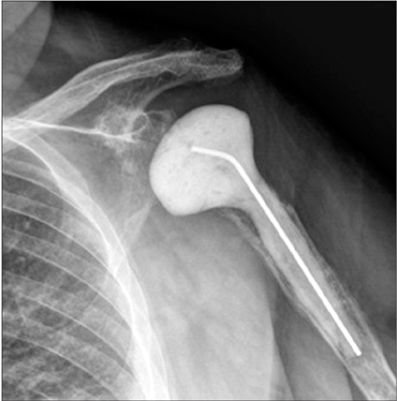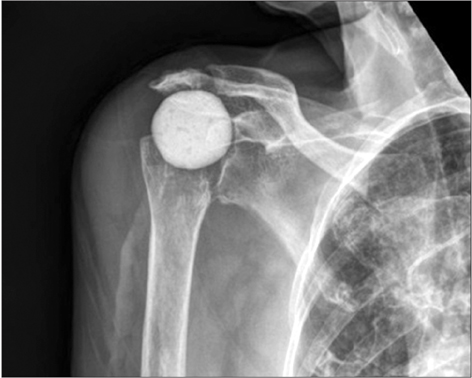Clin Orthop Surg.
2017 Dec;9(4):489-496. 10.4055/cios.2017.9.4.489.
Antibiotic Spacers in Shoulder Arthroplasty: Comparison of Stemmed and Stemless Implants
- Affiliations
-
- 1Department of Orthopaedic Surgery, Thomas Jefferson University Hospital, Philadelphia, PA, USA.
- 2Department of Orthopaedic Surgery, The Rothman Institute, Thomas Jefferson University Hospital, Philadelphia, PA, USA. surena.namdari@rothmaninstitute.com
- KMID: 2412250
- DOI: http://doi.org/10.4055/cios.2017.9.4.489
Abstract
- BACKGROUND
Antibiotic spacers in shoulder periprosthetic joint infection deliver antibiotics locally and provide temporary stability. The purpose of this study was to evaluate differences between stemmed and stemless spacers.
METHODS
All spacers placed from 2011 to 2013 were identified. Stemless spacers were made by creating a spherical ball of cement placed in the joint space. Stemmed spacers had some portion in the humeral canal. Operative time, complications, reimplantation, reinfection, and range of motion were analyzed.
RESULTS
There were 37 spacers placed: 22 were stemless and 15 were stemmed. The stemless spacer population was older (70.9 ± 7.8 years vs. 62.8 ± 8.4 years, p = 0.006). The groups had a similar percentage of each gender (stemless group, 45% male vs. stemmed group, 40% male; p = 0.742), body mass index (stemless group, 29.1 ± 6.4 kg/m² vs. stemmed group, 31.5 ± 8.3 kg/m²; p = 0.354) and Charlson Comorbidity Index (stemless group, 4.2 ± 1.2 vs. stemmed group, 4.2 ± 1.7; p = 0.958). Operative time was similar (stemless group, 127.5 ± 37.1 minutes vs. stemmed group, 130.5 ± 39.4 minutes). Two stemless group patients had self-resolving radial nerve palsies. Within the stemless group, 15 of 22 (68.2%) underwent reimplantation with 14 of 15 having forward elevation of 109°± 23°. Within the stemmed group, 12 of 15 (80.0%, p = 0.427) underwent reimplantation with 8 of 12 having forward elevation of 94°± 43° (range, 30° to 150°; p = 0.300). Two stemmed group patients had axillary nerve palsies, one of which self-resolved but the other did not. One patient sustained dislocation of reverse shoulder arthroplasty after reimplantation. One stemless group patient required an open reduction and glenosphere exchange of dislocated reverse shoulder arthroplasty at 6 weeks after reimplantation.
CONCLUSIONS
Stemmed and stemless spacers had similar clinical outcomes. When analyzing all antibiotic spacers, over 70% were converted to revision arthroplasties. The results of this study do not suggest superiority of either stemmed or stemless antibiotic spacers.
MeSH Terms
-
Aged
Aged, 80 and over
Anti-Bacterial Agents/*administration & dosage
Arthroplasty, Replacement, Shoulder/*adverse effects
Female
Hemiarthroplasty/adverse effects
Humans
Male
Middle Aged
Operative Time
Prosthesis-Related Infections/*drug therapy/microbiology/surgery
Range of Motion, Articular
Reoperation
Retrospective Studies
Shoulder Joint/physiopathology
Shoulder Prosthesis/*adverse effects
Tobramycin/administration & dosage
Vancomycin/administration & dosage
Anti-Bacterial Agents
Vancomycin
Tobramycin
Figure
Cited by 1 articles
-
Outcomes of Shoulder Arthroplasty Performed for Postinfectious Arthritis
Eric Michael Padegimas, Thema A Nicholson, Stephen Silva, Matthew L Ramsey, Gerald R Williams, Mark D Lazarus, Surena Namdari
Clin Orthop Surg. 2018;10(3):344-351. doi: 10.4055/cios.2018.10.3.344.
Reference
-
1. Padegimas EM, Maltenfort M, Ramsey ML, Williams GR, Parvizi J, Namdari S. Periprosthetic shoulder infection in the United States: incidence and economic burden. J Shoulder Elbow Surg. 2015; 24(5):741–746.
Article2. Florschutz AV, Lane PD, Crosby LA. Infection after primary anatomic versus primary reverse total shoulder arthroplasty. J Shoulder Elbow Surg. 2015; 24(8):1296–1301.
Article3. Clare DJ, Wirth MA, Groh GI, Rockwood CA Jr. Shoulder arthrodesis. J Bone Joint Surg Am. 2001; 83-A(4):593–600.
Article4. Coste JS, Reig S, Trojani C, Berg M, Walch G, Boileau P. The management of infection in arthroplasty of the shoulder. J Bone Joint Surg Br. 2004; 86(1):65–69.
Article5. Ince A, Seemann K, Frommelt L, Katzer A, Loehr JF. Onestage exchange shoulder arthroplasty for peri-prosthetic infection. J Bone Joint Surg Br. 2005; 87(6):814–818.
Article6. Jerosch J, Schneppenheim M. Management of infected shoulder replacement. Arch Orthop Trauma Surg. 2003; 123(5):209–214.
Article7. Levy JC, Triplet J, Everding N. Use of a functional antibiotic spacer in treating infected shoulder arthroplasty. Orthopedics. 2015; 38(6):e512–e519.
Article8. Rispoli DM, Sperling JW, Athwal GS, Schleck CD, Cofield RH. Pain relief and functional results after resection arthroplasty of the shoulder. J Bone Joint Surg Br. 2007; 89(9):1184–1187.
Article9. Sperling JW, Kozak TK, Hanssen AD, Cofield RH. Infection after shoulder arthroplasty. Clin Orthop Relat Res. 2001; (382):206–216.
Article10. Fitzgerald SJ, Hanssen AD. Surgical techniques for staged revision of the chronically infected total knee arthroplasty. Surg Technol Int. 2011; 21:204–211.11. Hanssen AD, Spangehl MJ. Practical applications of antibiotic-loaded bone cement for treatment of infected joint replacements. Clin Orthop Relat Res. 2004; (427):79–85.
Article12. Aggarwal VK, Rasouli MR, Parvizi J. Periprosthetic joint infection: current concept. Indian J Orthop. 2013; 47(1):10–17.
Article13. Parvizi J, Zmistowski B, Adeli B. Periprosthetic joint infection: treatment options. Orthopedics. 2010; 33(9):659.
Article14. Tsukayama DT, Goldberg VM, Kyle R. Diagnosis and management of infection after total knee arthroplasty. J Bone Joint Surg Am. 2003; 85-A:Suppl 1. S75–S80.
Article15. Stine IA, Lee B, Zalavras CG, Hatch G 3rd, Itamura JM. Management of chronic shoulder infections utilizing a fixed articulating antibiotic-loaded spacer. J Shoulder Elbow Surg. 2010; 19(5):739–748.
Article16. Chiang ER, Su YP, Chen TH, Chiu FY, Chen WM. Comparison of articulating and static spacers regarding infection with resistant organisms in total knee arthroplasty. Acta Orthop. 2011; 82(4):460–464.
Article17. Fehring TK, Odum S, Calton TF, Mason JB. Articulating versus static spacers in revision total knee arthroplasty for sepsis: the Ranawat Award. Clin Orthop Relat Res. 2000; (380):9–16.18. Pietsch M, Wenisch C, Traussnig S, Trnoska R, Hofmann S. Temporary articulating spacer with antibiotic-impregnated cement for an infected knee endoprosthesis. Orthopade. 2003; 32(6):490–497.19. Jaekel DJ, Day JS, Klein GR, Levine H, Parvizi J, Kurtz SM. Do dynamic cement-on-cement knee spacers provide better function and activity during two-stage exchange? Clin Orthop Relat Res. 2012; 470(9):2599–2604.
Article20. Sundararajan V, Henderson T, Perry C, Muggivan A, Quan H, Ghali WA. New ICD-10 version of the Charlson comorbidity index predicted in-hospital mortality. J Clin Epidemiol. 2004; 57(12):1288–1294.
Article21. Charlson ME, Pompei P, Ales KL, MacKenzie CR. A new method of classifying prognostic comorbidity in longitudinal studies: development and validation. J Chronic Dis. 1987; 40(5):373–383.
Article22. Dezfuli B, King JJ, Farmer KW, Struk AM, Wright TW. Outcomes of reverse total shoulder arthroplasty as primary versus revision procedure for proximal humerus fractures. J Shoulder Elbow Surg. 2016; 25(7):1133–1137.
Article23. Werner BS, Boehm D, Gohlke F. Revision to reverse shoulder arthroplasty with retention of the humeral component. Acta Orthop. 2013; 84(5):473–478.
Article24. Eichinger JK, Galvin JW. Management of complications after total shoulder arthroplasty. Curr Rev Musculoskelet Med. 2015; 8(1):83–91.
Article25. Ladermann A, Lubbeke A, Melis B, et al. Prevalence of neurologic lesions after total shoulder arthroplasty. J Bone Joint Surg Am. 2011; 93(14):1288–1293.
Article26. Bufquin T, Hersan A, Hubert L, Massin P. Reverse shoulder arthroplasty for the treatment of three- and four-part fractures of the proximal humerus in the elderly: a prospective review of 43 cases with a short-term follow-up. J Bone Joint Surg Br. 2007; 89(4):516–520.27. Cheung E, Willis M, Walker M, Clark R, Frankle MA. Complications in reverse total shoulder arthroplasty. J Am Acad Orthop Surg. 2011; 19(7):439–449.
Article28. Ladermann A, Williams MD, Melis B, Hoffmeyer P, Walch G. Objective evaluation of lengthening in reverse shoulder arthroplasty. J Shoulder Elbow Surg. 2009; 18(4):588–595.
Article29. Levy J, Frankle M, Mighell M, Pupello D. The use of the reverse shoulder prosthesis for the treatment of failed hemiarthroplasty for proximal humeral fracture. J Bone Joint Surg Am. 2007; 89(2):292–300.
Article30. Frangiamore SJ, Saleh A, Grosso MJ, et al. Early versus late culture growth of Propionibacterium acnes in revision shoulder arthroplasty. J Bone Joint Surg Am. 2015; 97(14):1149–1158.
Article
- Full Text Links
- Actions
-
Cited
- CITED
-
- Close
- Share
- Similar articles
-
- The radiographic and clinical outcomes of stemless reverse total shoulder arthroplasty: a minimum 2-year follow-up study
- Reconsidering the clinical outcomes of the stemless reverse total shoulder arthroplasty design implant
- Unlinked and Convertible Total Elbow Arthroplasty
- Reducing Dislocations of Antibiotic Hip Spacers via Hybrid Cement-screw Constrained Liner Fixation: A Case Series
- Recent Updates Regarding Outcomes and Complications of Reverse Total Shoulder Arthroplasty



